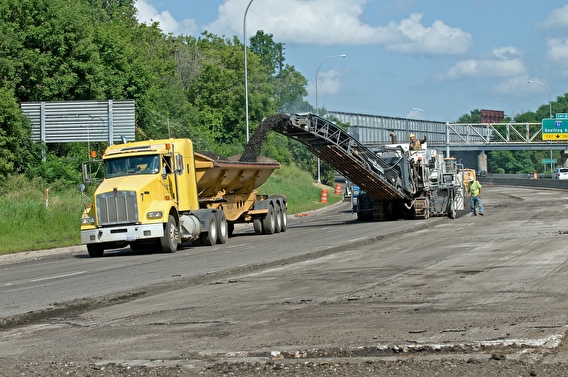
A driver ignores a ramp closure and veers into a paving project. Another swipes a barrel when driving while distracted. A third disregards a flagger and seriously injures her. Unfortunately, work-zone intrusions like these are a frequent occurrence for highway workers in Minnesota and around the US, where more than 100 workers are killed and many more are injured in road work zones each year.
In response to this critical worker safety threat, a U of M research team designed a smartphone-based work-zone-intrusion data entry tool in a project sponsored by the Minnesota Department of Transportation (MnDOT).
“Until recently there hasn’t been a dedicated app for reporting work-zone intrusions, so our understanding of these events has been limited,” says Department of Mechanical Engineering research fellow Brian Davis, the principal investigator.
The research team aimed to create a smartphone application that was easy to navigate, quick to use, and able to collect analyzable data from workers in the field. This would allow transportation agencies to track intrusion trends, assess risk factors, and develop countermeasures to reduce the likelihood of intrusions and improve worker safety.
The new app builds on earlier research that developed a process for workers to report intrusions using an online system and paper forms, which fed into a database of work-zone incidents. However, the process was not used consistently, resulting in limited data with which to identify commonalities or trends; it was determined that a mobile app enabling workers to report incidents quickly and easily would provide the data needed to better analyze risks and improve worker safety.
Researchers set out to design an app that put the highway workers’ needs first. To accomplish this, they began the process with two versions of the app: One design used drop-down menus (like the preexisting web form), while a second version used radio-style buttons like the paper form. Following multiple rounds of testing with MnDOT work crew end users, researchers optimized the final design’s features, content, and aesthetics to meet worker expectations and ensure high user acceptance.
According to testers, the final version—which featured radio-style buttons, improved “back” and “continue” buttons to accommodate smaller screens, and removed redundant questions—was a superior design.
“What you have right here, I will tell you compared to all the stuff that we’re used to, that we have been given over the last few years in technology—this is 100 times easier. It’s easier [and] it’s simpler,” said one participant.
An advantage of the final app design is its ability to enter a short report for less severe intrusions, requiring only the input of the incident’s date, time, location, and severity; this supports the goal of quick and efficient reporting. If the user indicates the intrusion was severe or workers were at risk, the need for an in-depth report is triggered; the report fully documents the intrusion with a higher level of detail for later analysis.
After the app’s design was complete, researchers conducted a test deployment and analyzed the data. They found that app-generated data held significant potential for providing useful and actionable information about work-zone intrusions, including the distribution of intrusions throughout the week, the most common types of intrusions, and what safety equipment tended to be most effective in mitigating risk.
“The work-zone intrusion app provides a way to report how, when, and where incidents are occurring, along with the capability to analyze the data, identify trends and, ultimately, keep incidents from happening,” Davis says.
In addition to the test data analysis, a sample infographic and analysis framework provide the basis for future reports such as intrusion types, safety equipment used, and work zone layout. The app for iPhone is currently available for download at Apple’s App Store. Infographics, flyers, a video, and the full report are available on the project page.
Following the app’s development, a pilot deployment was completed during two summer work seasons. “I think this app would be a useful tool for any agency interested in tracking and analyzing work-zone intrusions for improved worker safety,” Davis adds. “Our pilot with MnDOT was successful, and we are interested in continuing this work with other agencies.”
While the app is not currently in use at MnDOT, Steve Blaufuss believes the project was a success. “We hope that our future use of the app will be much more commonplace,” says Blaufuss, MnDOT statewide maintenance work zone and operations specialist. “Our field staff recognizes the value and productivity in fixing roads—documentation is a necessary evil in their eyes. It’s why we carefully regulate how much we ask of them regarding documentation. This app was a good effort in reducing that.”
—Megan Tsai, contributing writer

